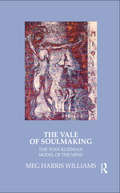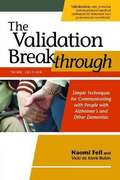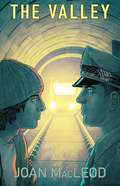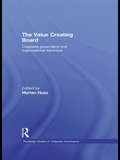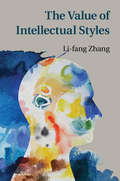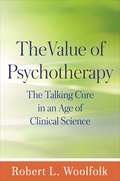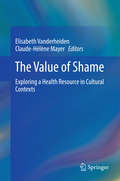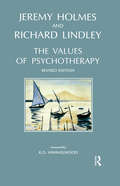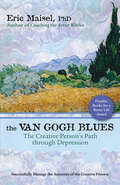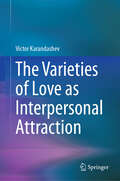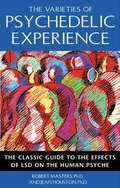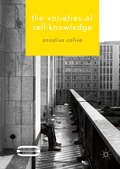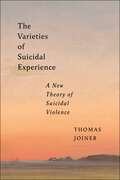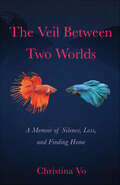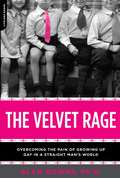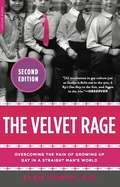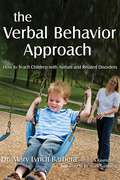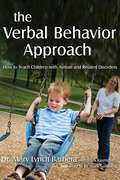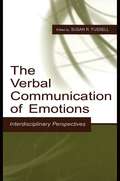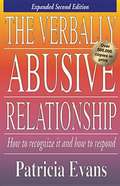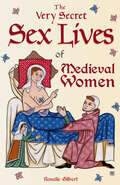- Table View
- List View
The Vale of Soulmaking: The Post-Kleinian Model of the Mind
by Meg Harris WilliamsThe post-Kleinian model of the mind, as developed by W. R. Bion and Donald Meltzer, is essentially an aesthetic one. It is founded on Melanie Klein's discovery of the "internal object" with its combined masculine and feminine qualities and ambiguous, awe-inspiring nature. Turbulent emotional experiences are repeatedly transformed through symbol-formation, on the basis of the internal relationship between the infant self and its object; and the aesthetic containment provided by this "counter-transference dream" (as Meltzer put it) enables the mind to digest its conflicts and develop.This search for a pattern that can make "contrary" emotions thinkable is modelled by all art forms and accounts for their universal significance. It is a process that can be observed particularly clearly in literature, in the form of the romance between the poet and his Muse (the traditional formulation of the psycho-analytic internal object).
The Validation Breakthrough: Simple Techniques for Communicating with People with Alzheimer's and Other Dementias, Third Edition
by Naomi Feil Vicki de Klerk-RubinValidation is a practical way of communicating with and managing problem behavior in older adults with Alzheimer's type dementia. It helps reduce stress, enhance dignity, and increase happiness. The Validation Breakthrough is an essential resource for all settings providing dementia care including assisted living facilities, nursing homes, skilled nursing facilities, hospice, home health care, adult day services, family care settings, and more.
The Valley
by Joan Macleod"MacLeod has a wonderful ear and eye for the everyday details."--Calgary HeraldInspired by the 2007 Tasering death of Robert Dziekanski at the Vancouver airport, The Valley dramatizes the volatile relationship between law enforcement and people in the grip of mental illness. The play connects both sides of this relationship by portraying two families embattled with depression, each guided by good intentions but challenged by their own flawed humanity.Joan MacLeod is the author of numerous award-winning plays. Her work has been translated into more than eight languages with productions throughout the world, including a sold-out run in New York.
The Value Creating Board: Corporate Governance and Organizational Behaviour (Routledge Studies in Corporate Governance)
by Morten HuseThis book presents boards of directors from a strategic and entrepreneurial management perspective. Boards of directors are receiving increased interest in the business world as well as among academic audiences however few contributions integrate corporate governance and organizational behavior. In this book a research stream about value-creating boards is introduced. Boards of directors have during the recent decades mostly been studied within a framework of corporate governance where the interests of external investors are emphasized. This book aims to go further and explore actual board behavior. The framework and the contributions in the book include concepts such as: board leadership and structure, boardroom decision-making, board task performance corporate entrepreneurship and innovation boards in small and medium-sized firms board diversity and women directors The book also presents the results of a research agenda about value-creating boards which was conducted throughout various European countries.
The Value of Intellectual Styles
by Zhang Li-FangIntellectual styles are individuals' preferred ways of using their abilities. This book provides the first comprehensive and systematic review of existing research on the value and desirability of different intellectual styles. By critically analyzing findings from hundreds of international studies undertaken over eight decades, Li-fang Zhang demonstrates that the creativity-generating Type I styles are generally superior to the norm-conforming Type II styles in relation to a wide range of learning processes and developmental outcomes, work performance, physical and mental health, and many other domains of people's lives. She further demonstrates that people explicitly and implicitly express their preference for Type I styles over Type II styles. Professor Zhang elucidates the practical value of cultivating diverse intellectual styles, especially Type I styles, in both academic and nonacademic settings, and lays the groundwork for future research to advance the field of intellectual styles and to inform scholarly work in other academic disciplines.
The Value of Psychotherapy
by Robert L. WoolfolkPsychotherapy as a discipline is very much in flux. From a seasoned scholar, clinician, and teacher, this engaging book offers a thoughtful and current analysis of where the field is now and where it may be headed. Robert L. Woolfolk illustrates how the growing medicalization of mental health care--in particular, the attempt to fit psychotherapy to the templates of evidence-based medicine--have challenged psychotherapists to reaffirm the value of their work. The book explores ways in which certain kinds of efforts to endow "the talking cure" with greater scientific legitimacy can be problematic. Woolfolk makes a strong case for the benefits of psychotherapy not only as a technology for treating disorders, but also as a practice that can promote practical wisdom and human flourishing.
The Value of Shame
by Elisabeth Vanderheiden Claude-Hélène MayerThis volume combines empirical research-based and theoretical perspectives on shame in cultural contexts and from socio-culturally different perspectives, providing new insights and a more comprehensive cultural base for contemporary research and practice in the context of shame. It examines shame from a positive psychology perspective, from the angle of defining the concept as a psychological and cultural construct, and with regard to practical perspectives on shame across cultures. The volume provides sound foundations for researchers and practitioners to develop new models, therapies and counseling practices to redefine and re-frame shame in a way that leads to strength, resilience and empowerment of the individual.
The Values of Psychotherapy (Studies In Bioethics)
by Jeremy Holmes Richard LindleyThis first-class book provides an unrivalled basis for further discussion on to how to make psychotherapy more effective both, ethically and professionally. Above all, psychotherapy is a moral practice. However scientific its research, or however much scientific research is demanded of it, psychotherapy remains a practice born of moral dilemmas, of how we live together, each with the other...Above all, the book is a plea to accept psychotherapy as a profession.
The Van Gogh Blues: The Creative Persons Path Through Depression
by Eric MaiselCreative people will experience depression — that’s a given. It’s a given because they are regularly confronted by doubts about the meaningfulness of their efforts. Theirs is a kind of depression that does not respond to pharmaceutical treatment. What’s required is healing in the realm of meaning.In this groundbreaking book, Eric Maisel teaches creative people how to handle these recurrent crises of meaning and how to successfully manage the anxieties of the creative process. Using examples both from the lives of famous creators such as van Gogh and from his own creativity coaching practice, Maisel explains that despite their inevitable difficulties, creative people possess the ability to forge relationships, repair themselves, and find meaning in their work and their lives. Maisel presents a step-by-step plan to help creative people handle their special brand of depression and rediscover the reasons they are driven to create in the first place.
The Vandal
by Anne SchraffSunday night somebody broke into Thomas Jefferson High. Since it rained that night, most of the neighbors were inside their houses. So nobody saw the vandal strike. Besides the smashed glass on the back door, the only damage was to the art room. But there the vandal had attacked with fury.
The Varieties of Love as Interpersonal Attraction
by Victor KarandashevJoining other publications on love by this author, the current volume examines the great varieties of love as interpersonal attraction. Drawing on classical and recent studies from global perspectives, it explores the components, dimensions, and contexts of interpersonal attraction. Its comprehensive coverage includes biological, physical, psychological, social, and cultural perspectives to give a full scientific picture of love as attraction in animals and humans. This book is relevant to professionals and researchers who seek an in-depth knowledge of love and interpersonal attraction, the key aspects of studies in a range of scientific areas.
The Varieties of Psychedelic Experience: The Classic Guide to the Effects of LSD on the Human Psyche
by Robert Masters Jean HoustonThe research in this book has great significance to the current debate on drug legalization and on the effects of LSD on the human psyche.
The Varieties of Religious Experience
by William JamesHarvard philosopher William James's compiled lectures on religion, considered to be among the most brilliant studies of mankind's relation to the divine <P><P> William James's Varieties of Religious Experience brings together twenty lectures on the nature of religion, delivered at the University of Edinburgh between 1901 and 1902. Renowned at the time for their practical and even-handed approach to the human experience of religion, the lectures form a sympathetic and analytical portrait not of the church, but of the personalized experiences of religious life. James examines the words of writers and philosophers from Immanuel Kant to Plato to Ralph Waldo Emerson to Marcus Aurelius in his investigations of faith, the soul, and systems of belief. Praised by philosopher Charles Pierce for its "penetration into the hearts of people" and by the New York Times for its ability to stir the sympathies of readers, The Varieties of Religious Experience is a lucid and thought-provoking examination of man's encounters with God.<P> Chosen for Mark Zuckerberg's "A Year of Books"
The Varieties of Self-Knowledge
by Annalisa ColivaThis book explores the idea that self-knowledgecomes in many varieties. We "know ourselves" through many different methods,depending on whether we attend to our propositional attitudes, our perceptions,sensations or emotions. Furthermore, sometimes what we call "self-knowledge" isnot the result of any substantial cognitive achievement and the characteristicauthority we grant to our psychological self-ascription is a conceptualnecessity, redeemed by unravelling the structure of several interlocking concepts. This book critically assesses the main contemporary positions held on theepistemology of self-knowledge. These include robust epistemic accounts such asinner sense views and theory-theories; weak epistemic accounts such astransparency theories and rational internalism and externalism; as well asexpressivist and constitutivist approaches. The author offers an innovative"pluralist" position on self-knowledge, emphasizing the complexity of thephenomenon and its resistance to any "monistic" treatment, to pose new andintriguing philosophical challenges.
The Varieties of Suicidal Experience: A New Theory of Suicidal Violence (Psychology and Crime)
by Thomas JoinerPROSE Award Finalist for Psychology and Applied Social WorkArgues that a range of behaviors such as murder-suicide, terrorism, and mass shootings are better understood as motivated by suicidal impulses than by homicidal onesMass shooters often display behaviors that strongly mirror the warning signs for suicide: lives led in isolation, intense personal suffering, disaffection, and struggle. Letters detailing why they did what they did paint pictures of intense misery and loneliness. As this book makes clear, private despair sometimes leads to social violence.In this groundbreaking work, Thomas Joiner offers a unified theory of suicide, making the case that many acts that appear homicidal are best understood primarily as suicidal. We must recognize that there are several forms of suicidal violence, some of which masquerade as other types of acts, including terrorism and murder. These include suicide-by-cop, suicide terrorism, murder-suicide, and running amok. Though there are obvious differences among these acts, Joiner argues that framing them as stemming from a common ideology of suicide is a crucial step in preventing these atrocities.By recognizing the desire to die—not to kill—as being at the heart of many of the acts of those who choose to kill their partner, shoot up their school, or terrorize their community, we can offer more effective measures of intervention. At a time when our nation is scrambling for solutions in the fight to end gun violence, this book presents a crucial component in the detection and treatment of unwell individuals.
The Veil Between Two Worlds: A Memoir of Silence, Loss, and Finding Home
by Christina VoChristina Vo has always struggled with the concept of “home.” The daughter of an emotionally distant father and a mother who died when she was just fourteen, she continues to grapple with that legacy of loss and her constant quest to, as a fortysomething, find a reconciliation with the shape her life has taken. In January 2021, feeling a call to be closer to the land, she decides to leave San Francisco—this time permanently, she hopes—and set off on a road trip with one of her closest friends, David.Christina and David begin their journey with an ayahuasca ceremony in Santa Barbara, then continue on to Ojai and ultimately Santa Fe—two magical lands that serve as deep portals for healing. Throughout their travels, Christina reflects on the recent and distant past: her relationships, her past experiences in Santa Barbara and Ojai (where she stayed for nine months around her fortieth birthday, two years ago) and her evolving understanding of her relationship with her parents. All the while, she ponders how the past has shaped her current identity as a single, childless, and motherless woman in her forties. Within the context of intimate friendship, she discovers how thin the veil between worlds can be, and gradually comes to realize that her mother’s spirit has accompanied her since day one of her journey.Deeply reflective and ultimately joyful, Vo’s memoir takes us on a journey between two worlds—the physical and the spiritual—that eventually brings her to a newfound understanding of how to deepen connections with others, as well as to a place of peace and home within herself.
The Vein of Gold: A Journey to Your Creative Heart (Artist's Way)
by Julia CameronIn the Vein of Gold: A Journey to Your Creative Heart, Julia Cameron, author of The Artist's Way, draws from her remarkable teaching experience to help readers reach out into ever-broadening creative horizons. As in The Artist's Way, she combines eloquent essays with playful and imaginative experiential exercises to make The Vein of Gold an extraordinary book of learning-through-doing. Inspiring essays on the creative process and more than one hundred engaging and energizing tasks involve the reader in "inner play," leading to authentic growth, renewal, and healing.
The Velvet Rage
by Alan DownsThe gay male world today is characterized by seductive beauty, artful creativity, flamboyant sexuality, and, encouragingly, unprecedented acceptability in society. Yet despite the progress of the recent past, gay men still find themselves asking, "Are we really better off?" The inevitable byproduct of growing up gay in a straight world continues to be the internalization of shame, a shame gay men may strive to obscure with a fa?ade of beauty, creativity, or material success. Drawing on contemporary psychological research, the author's own journey to be free of anger and of shame, as well as the stories of many of his friends and clients, The Velvet Rage outlines the three distinct stages to emotional well-being for gay men. Offering profoundly beneficial strategies to stop the insidious cycle of avoidance and self-defeating behavior, The Velvet Rage is an empowering book that will influence the public discourse on gay culture, and positively change the lives of gay men who read it.
The Velvet Rage
by Alan DownsThe gay male world today is characterized by seductive beauty, artful creativity, flamboyant sexuality, and, encouragingly, unprecedented acceptability in society. Yet despite the progress of the recent past, gay men still find themselves asking, "Are we really better off?" The inevitable byproduct of growing up gay in a straight world continues to be the internalization of shame, a shame gay men may strive to obscure with a fa?ade of beauty, creativity, or material success. Drawing on contemporary psychological research, the author's own journey to be free of anger and of shame, as well as the stories of many of his friends and clients, The Velvet Rage outlines the three distinct stages to emotional well-being for gay men. Offering profoundly beneficial strategies to stop the insidious cycle of avoidance and self-defeating behavior, The Velvet Rage is an empowering book that will influence the public discourse on gay culture, and positively change the lives of gay men who read it.
The Velvet Rage: Overcoming the Pain of Growing Up Gay in a Straight Man's World
by Alan DownsOC "The Velvet Rage" is becoming a touchstone in gay culture just as "Goodbye to Berlin" was in the 30s, "A BoyOCOs Own Story" in the 60s and "Faggots" in the 70s. OCO--"Observer" (UK)a
The Verbal Behavior Approach: How to Teach Children with Autism and Related Disorders
by Mary Lynch Barbera Tracy RasmussenThe Verbal Behavior (VB) approach is a form of Applied Behavior Analysis (ABA), that is based on B.F. Skinner's analysis of verbal behavior and works particularly well with children with minimal or no speech abilities. In this book Dr. Mary Lynch Barbera draws on her own experiences as a Board Certified Behavior Analyst and also as a parent of a child with autism to explain VB and how to use it. This step-by-step guide provides an abundance of information about how to help children develop better language and speaking skills, and also explains how to teach non-vocal children to use sign language. An entire chapter focuses on ways to reduce problem behavior, and there is also useful information on teaching toileting and other important self-help skills, that would benefit any child. This book will enable parents and professionals unfamiliar with the principles of ABA and VB to get started immediately using the Verbal Behavior approach to teach children with autism and related disorders.
The Verbal Behavior Approach: How to Teach Children with Autism and Related Disorders
by Mary Lynch BarberaA step-by-step guide on how to help children develop language and speaking skills.The Verbal Behavior (VB) approach is a form of Applied Behavior Analysis (ABA), that is based on B.F. Skinner's analysis of verbal behavior and works particularly well with children with minimal or no speech abilities. In this book Dr. Mary Lynch Barbera draws on her own experiences as a Board Certified Behavior Analyst and also as a parent of a child with autism to explain VB and how to use it.This step-by-step guide provides an abundance of information about how to help children develop better language and speaking skills, and also explains how to teach non-vocal children to use sign language. An entire chapter focuses on ways to reduce problem behavior, and there is also useful information on teaching toileting and other important self-help skills, that would benefit any child.This book will enable parents and professionals unfamiliar with the principles of ABA and VB to get started immediately using the Verbal Behavior approach to teach children with autism and related disorders.(P)2017 Hodder & Stoughton Limited
The Verbal Communication of Emotions: Interdisciplinary Perspectives
by Susan R. FussellThis book pulls together new research and theory on the verbal communication of emotions by an international, cross-disciplinary group of recognized experts in affective communication. The book's goal is to provide readers with a comprehensive view of current research and encourage cross-disciplinary interaction. Topics include analyses of literal and figurative expressions for emotions, studies of the use of metaphor and other figurative expressions for emotion, analysis of the role of conversational partners in creating emotional meaning, and the effects of culture on emotional communication. The chapters are organized into three broad areas: background theory, figurative language use, and social/cultural aspects of emotional communication. Part I reviews fundamental issues in the verbal communication of emotion. Part II examines the role of metaphor and other figures of speech in emotional communication in both everyday language and psychotherapeutic contexts. Part III looks at ways emotions are embedded in larger socio-culture processes. Taken as a whole, the chapters provide a comprehensive look at the current state of research on the use of language in affective communication and suggest a number of interesting directions for future research.
The Verbally Abusive Relationship: How to Recognize It and How to Respond
by Patricia EvansVerbal abuse doesn't leave the same physical evidence as battery, but it can be just as painful, and can actually take longer to recover from. The new edition of this important reference covers the most recent developments in dealing with verbal abuse and answers the questions readers ask most on the subject.
The Very Secret Sex Lives of Medieval Women: An Inside Look At Women And Sex In Medieval Times (true Stories, Women In History)
by Rosalie GilbertA “wickedly entertaining, informative and thought-provoking” look at romance, courtship, and other intimacies behind closed Medieval doors (Dr. Markus Kerr, PhD, MDR).Were medieval women slaves to their husband’s desires, jealously secured in a chastity belt in his absence? Was sex a duty or could it be a pleasure? Did a woman have a say about her own female sexuality, body, and who did or didn’t get up close and personal with it? No. And yes. It’s complicated.The intimate lives of medieval women were as complex as for modern women. They loved and lost, hoped and schemed, were lifted up and cast down. They were hopeful and lovelorn. Some had it forced upon them, others made aphrodisiacs and dressed for success. Some were chaste and some were lusty. Having sex was complicated. Not having sex, was even more so.Inside The Very Secret Sex Lives of Medieval Women, a fascinating book about life during medieval times, you will discover tantalizing true stories about medieval women and a myriad of historical facts. Learn about:The true experiences of women from all classes, including women who made historyThe dos and don’ts in the bedroomSexy foods and how to have themAll you need to know for your wedding night, and well as insider medical adviceHow to get pregnant (and how not to), and more“Quite compelling and hilariously funny. I have been chuckling out loud and my husband says he thinks he ought to read it if it’s such a tonic. God forbid!” —Susanna Newstead, author of the Savernake Novels
